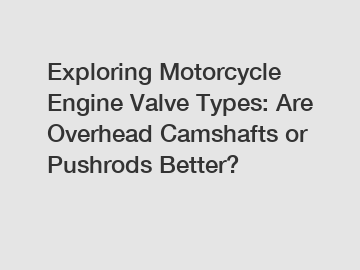Dec. 15, 2023
Machinery
When it comes to the intricate world of motorcycle engines, one of the most fascinating debates revolves around the valve types used. Motorcycle enthusiasts and engineers have long deliberated over the advantages and disadvantages of overhead camshafts (OHC) versus pushrods. In this article, we will delve deeper into these two valve systems to understand the differences, benefits, and ultimately, which one is better suited for your motorcycle.
Understanding the Basics:
First, let's familiarize ourselves with the fundamental principles behind both systems. The engine valve serves as a gateway for air and fuel to enter the combustion chamber and exhaust gases to exit. It plays a crucial role in determining the engine's performance, efficiency, and overall power output.

Overhead Camshafts:
One of the most prevalent valve types in modern engines, OHC systems feature the camshaft positioned above the valves. This design offers several advantages. Firstly, it allows for more precise control of valve timing and lift, resulting in improved engine performance and fuel efficiency. Additionally, OHC systems typically boast a larger number of valves, enhancing airflow and increasing power output. Moreover, the reduced mass of the valve train enables higher engine speeds, making OHC engines exceptionally responsive.
Pushrod Systems:
In contrast, pushrod systems employ a simpler design, with the camshaft placed within the engine block. The camshaft operates a set of pushrods, which in turn activate the valves positioned in the cylinder heads. While pushrod systems have been around for decades, they still possess certain unique advantages. Due to their compact design, these engines tend to be lighter and more compact, allowing for easier installation in motorcycles with tighter spatial constraints. Additionally, the pushrod design often results in lower manufacturing costs, making it an attractive option for budget-conscious riders.
Key Pros and Cons:
To help you better understand the trade-offs between these two valve types, let's explore some key advantages and disadvantages:
Overhead Camshafts:
Pros:
1. Greater valve control allows for high-revving engines with improved overall performance.
2. More valves facilitate better combustion efficiency, resulting in enhanced power output.
3. Reduced mass of the valve train aids in attaining higher engine speeds and responsiveness.
Cons:
1. Increased complexity may lead to higher maintenance costs.
2. Manufacturing overhead camshafts can be more expensive, potentially raising the initial purchase cost of the motorcycle.
3. Limited lubrication can cause camshaft wear over time, necessitating careful maintenance and scheduled oil changes.
Pushrod Systems:
Pros:
1. Simpler design often translates to lower manufacturing and maintenance costs.
2. Compact size allows ease of installation, especially in motorcycles with limited space.
3. Increased low-end torque improves off-the-line acceleration, making pushrod engines ideal for cruising or touring motorcycles.
Cons:
1. Limited number of valves can restrict airflow and impact overall performance potential.
2. Lower RPM limits compared to OHC systems, resulting in decreased top-end power.
3. Increased weight due to the valve train design hampers overall performance and agility.
Conclusion:
In the end, determining whether OHC or pushrod valve systems are better for your motorcycle depends on numerous factors such as intended use, personal preferences, and budget. If you value high-revving performance, improved power output, and precise valve control, OHC systems are likely the better choice. However, if you prioritize low-end torque, compact designs, and cost-efficiency, pushrod systems might suit your needs better.
Ultimately, the ongoing advancements in engineering and manufacturing have narrowed the gap between these two valve types. Whichever system you choose, the most important aspect is to ensure regular maintenance and care to keep your motorcycle's heart beating strong. So, in your quest for the perfect two-wheeled companion, remember that the best engine valve system is the one that aligns with your specific needs, riding style, and long-term goals.
Are you interested in learning more about 272 050 08 01, Engine Valve for Korean cars, 6150-41-4111? Contact us today to secure an expert consultation!
If you are interested in sending in a Guest Blogger Submission,welcome to write for us!
All Comments ( 0 )